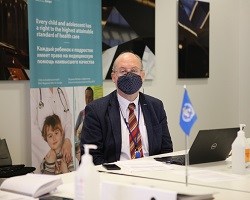Schooling in the time of COVID-19: Opening statement at high-level meeting on keeping schools open and protecting all children amid surging COVID-19 cases

WHO
Opening statement by Dr Hans Henri P. Kluge, the Regional Director of WHO Europe, at the 2nd high-level meeting jointly organized by the WHO Regional Office for Europe and the Ministry of Health, Italy
8 December 2020
Minister Speranza,
Malika, Frida, Emilia [youth advisers to the technical advisory group],
Member States, partners, colleagues,
Since we last met in August, much has changed. In the new school year, after having experienced total lockdowns in the early phase of this crisis, we saw children returning to reopened schools – a courageous and positive achievement. Our understanding of the virus also became more sophisticated and we were beginning to prepare for what we knew would be a complicated autumn and winter.
Today, Europe is again the epicentre of the pandemic. But while we are grappling with a surge in cases, we now say with certainty that closing schools should be a measure of last resort.
School closures and interventions, such as distance learning, may have a negative effect on children’s long-term educational outcomes. Children living with disabilities are further disadvantaged by school closures and inadequate distance-learning measures to meet their needs. We owe it to the next generation, particularly those in vulnerable settings, to do everything we can to reduce vulnerabilities and to keep their in-person learning alive.
The evidence is growing that targeting transmission in our communities will address the risk of transmission in schools. If proper and consistent measures are in place, schools do not pose a greater risk of infection for children and teachers and other staff than any other public place.
The technical advisory group has provided us with some important recommendations which we will continue to use to inform our advocacy and response.
- While children are not the drivers of this pandemic, they risk being among its biggest victims. Though children are largely spared from the direct health effects of COVID-19, the measures put in place to control the pandemic are having a profound effect on their health and well-being.
- Effective policy considerations for the coming school year will focus on the goal of having children and adolescents physically present in school. The purpose of this meeting is to agree on measures to safely do so without doing additional harm to children.
- Public health approaches need to balance all effects of the measures. We must monitor our actions carefully and adapt our actions as more evidence becomes available so that we do not do more harm than good.
Central to all these efforts should be a focus on children living in vulnerable situations. They continue to be disproportionately affected by the pandemic and by subsequent school closures. I hope today we focus efforts to minimize the impact on their long-term health outcomes and to determine sound, sustainable strategies to address the digital divide and other specific challenges they face in learning.
This forum is important for the WHO European Region as we continue to navigate the way through this crisis. I would like to acknowledge Minister Speranza for spearheading this initiative, and the members of the technical advisory group for providing the evidence base for this important issue. I would particularly like to thank our youth advisers for their vital contribution and commitment to safe schooling for children across our Region.
We have an important opportunity now to build a coalition across our Member States to inform or actions and move forward together to implement the best possible measures for all, particularly our children and young people. Let us not fail the next generation.
Thank you.



